Is a More Expensive Suspension System Really Worth the Money?
One of the most popular modifications an owner can do to their truck is raising the suspension to fit a bigger set of tires. Trucks are often driven through the sand, over rocks and through rough terrain, so along with the extra traction from the bigger tires, a little more ground clearance will greatly increase the functionality of the rig and improve the looks as well. But have you ever looked at all the different suspension kits available and wondered what the difference was between them? Prices for a suspension system can range from a few hundred to several thousand dollars, and while on the surface it might seem like they all accomplish the same task of raising the suspension, the difference is in the handling, ride quality, and suspension travel. A few key components can make the difference between a harsh ride on a smooth highway and a truck that can fly across the desert with ease. So which parts do you need on your suspension kit?
How a Leveling or Lift Kit Works
In the world of solid axle trucks there are two basic suspension designs used: the radius arm which was found on 2013+ Ram 2500s and 2014+ Ram 3500s, as well as 2005 and newer Superduty trucks, and the 4-link which was used from 1994 to 2013 on Ram trucks. Both the radius arm and 4-link front suspension design use a coil spring to hold up the weight of the truck. Most HD trucks use a leaf spring and solid axle combo out back, except the Ram 2500 from 2014 and newer, as they switched to a rear 4-link design with coil springs.
In order to lift the front of a coil sprung solid axle truck, a variety of methods are used. The most basic kits simply insert a spacer between the original coil spring and the frame and may include shock extending brackets or longer shocks to prevent “topping out” the stock ones. As you go up in quality and price, kits will include new coil springs that are longer and require no spacers, better shocks, and drop brackets for things like the radius arms or track bar that correct the suspension geometry in the new raised position.
On the rear of a leaf sprung truck, an entry level suspension kit will add height by placing a lift block in between the leaf spring and axle. Longer U-bolts will be provided to safely secure the spring to the axle, and new rear shocks round out the basics of the kit. In some instances, you can opt for a taller than stock leaf spring which lifts the truck with no spacer required. To raise the rear of a rear coil sprung Ram 2500, taller coils are employed.
As you can see, there are tons of different parts you could install to raise the suspension on your Diesel, but there are so many different options and brands, it can be hard to decide which is right for you. To make things a little clearer, we’ll break it down on a part-by-part basis and discuss the applications of each, since how you drive your truck determines which lifting method you should use.
Spacers, Linear Rate, or Progressive Rate Coil Springs?
A BDS 2” Suspension leveling kit for the 2014 to 2022 Ram 2500 gets its lift from a fabricated spacer that installs up front between the spring and the frame. This gives you the clearance to run larger tires, and since it retains your factory coil springs, the ride quality and carrying capacity will remain basically the same as before. If you find yourself towing and hauling at maximum GVWR often, this type of leveling kit may be the best bet for you since the stock coils are extremely stiff.
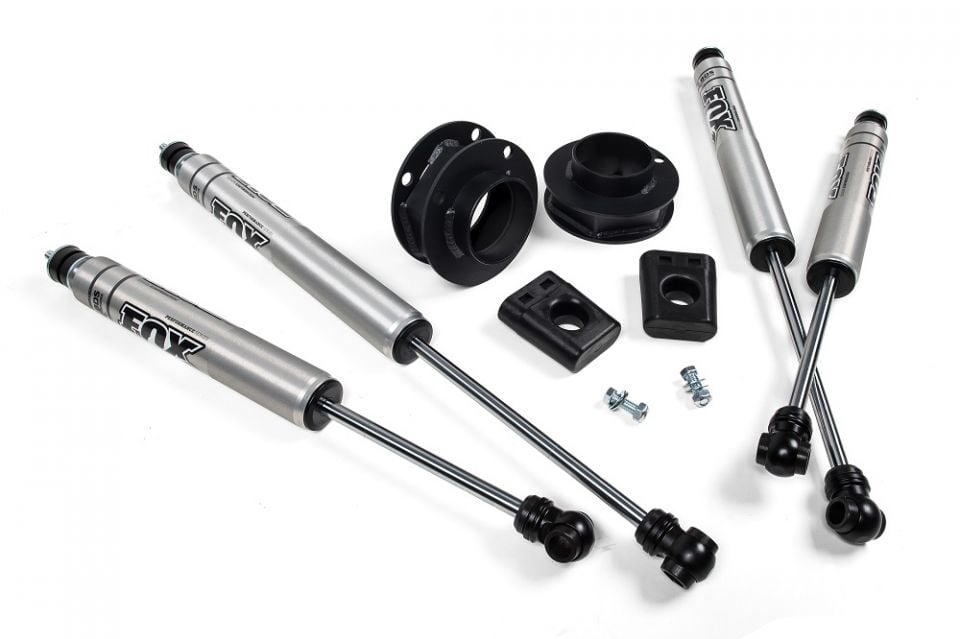
However, if you find the stock ride quality of your truck is a bit too harsh for your liking and you want to make your truck a little more comfortable, a new set of Carli front coil springs are worth a look. Sure, they cost a few bucks more than a spacer, but Carli springs are designed with a slightly softer rate than stock which dramatically increases ride comfort, but still allows the truck to be used as it was intended. Because the new springs do have a slightly softer rate, your load carrying capacity does go down a tiny bit, but unless you use your truck at max GVWR, this shouldn’t be a huge deal. Carli also offers both a linear rate and progressive rate spring. The linear rate spring requires the same amount of incremental force to compress regardless of how far it is compressed, and the progressive rate spring is softer at first, but the spring rate increases as the suspension is compressed further.
It’s worth mentioning the spring choice you make will affect the rest of the components required to complete your suspension system (specifically the shocks), and to decide between spacers, a linear rate coil, or multi-rate springs, you should really figure out your priorities. For the ultimate strength while towing and hauling or for those on a budget, a coil spacer can be the answer, but if you demand a smoother ride quality and better performance both on and off road, you should really consider stepping up to a linear or multi rate coil spring. Yes, they will cost more, but the finished product will perform much better.
Shock Options
In the simplest terms, the purpose of a shock absorber is to control the motion of the suspension, and there are a wide range of shocks to choose from when you purchase your suspension system. The basic leveling kits come with a nitrogen charged twin tube shock which functions very similar to your factory shock absorber, but they are a little bit longer to accommodate your lifted ride height. They are a great entry level shock and will provide a decent ride on the highway, but if you venture off the beaten path, they will not be the ideal shock for you. As your suspension travels up and down, the shock absorbers will heat up as they fight the motion of the suspension. On a smooth road, there isn’t a ton of motion to absorb, so not much heat is generated, and a stock shock will perform just fine. As the going gets bumpy, the increased suspension movement can quickly overwhelm and overheat the OEM shocks, which can lead to degraded handling.
While they are a bit more expensive, an upgraded set of shocks is a must-do modification for any diesel pickup with lifted or even stock suspension. BDS leveling kits have the option to upgrade to a FOX 2.0 Performance Series shock, and Carli offers their Signature Series shock as well as their own custom tuned Fox 2.0, any of which will deliver a smoother ride than the OEM shocks, whether you’re on the highway, towing, or on a dirt road. Most diesel truck owners will fall into the category where any of the Fox 2.0 family of shocks will be the ideal balance between performance and budget, but there are still other choices out there.
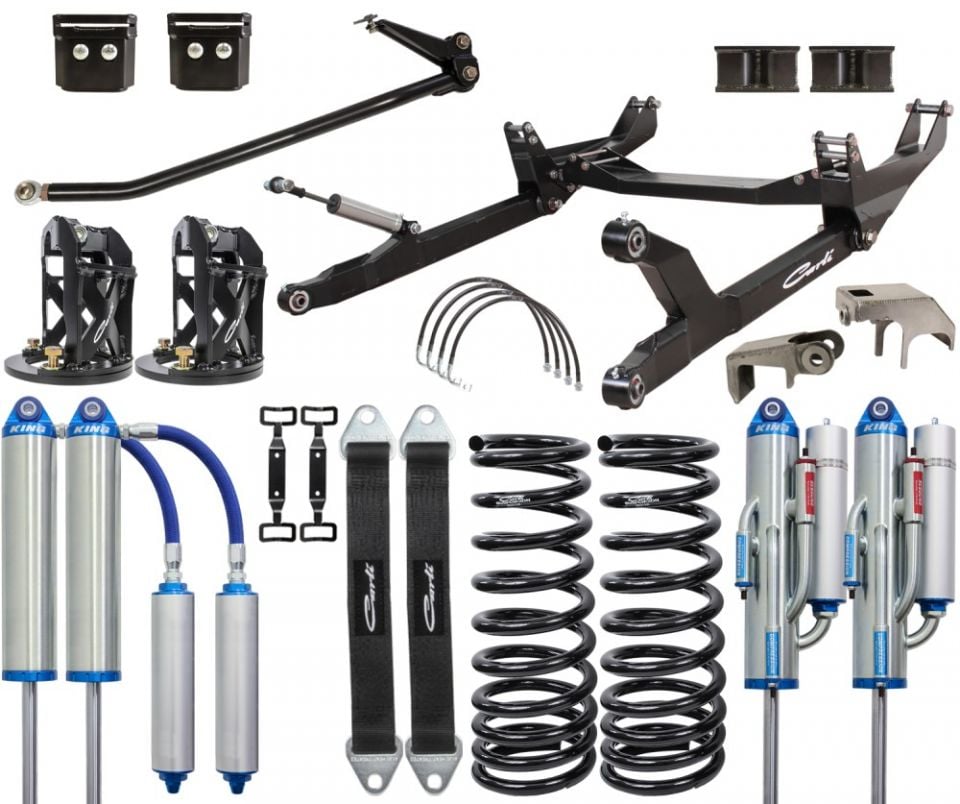
If you continue to look at different shock packages, you’ll notice there are some pretty “exotic” options available, and at first you may get sticker shock when you see it’s possible to spend over $2,500 for a set of four shocks, but the old saying “you get what you pay for” is especially true for shocks. If your truck spends more time off road than on, and when it’s in the dirt you really push the go pedal to the floor, a quality shock is necessary to control the motion of the suspension and keep the tires planted as you blast over the river and through the woods. The truth is a shock package like the Carli 3.5″ Unchained Quadruple Bypass is overkill for most truck owners, but there are some trucks out there that are pushing the limits, and they need a shock that can keep up.
Lift Blocks, Add-A-Pack, or New Leaf Springs?
The least expensive way to lift the rear of any leaf sprung truck is to simply install some lift blocks, but this has the potential to introduce some new problems like wheel hop and axle wrap under acceleration. Many owners who use lift blocks also choose to install some sort of traction bar to fight against wheel hop, but unfortunately the combination of a lift block and traction bar won’t do anything to improve the ride quality or wheel travel of the rear suspension.
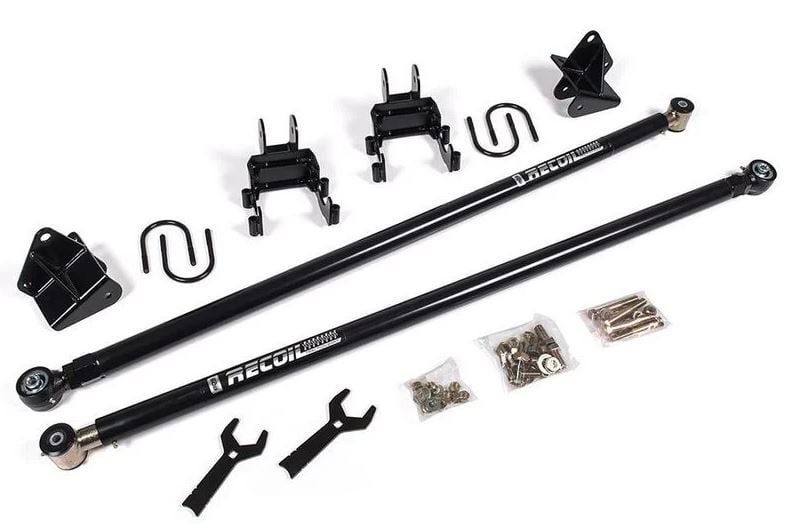
If you are sick of your diesel truck’s harsh ride and want to lift the rear while maintaining the OEM load carrying capacity, the best solution is an Add-A-Pack rear spring from Carli. They work in conjunction with your stock leaf springs and install underneath the main pack in place of the single factory overload spring. Because of the multiple thin leaf design, they work to improve the ride quality without sacrificing load carrying capability, and in total will provide about 2 inches of lift. Most diesel owners would fall into the category where an add-a-pack would be appropriate.
If you need a little more wheel travel for fast off-road adventures and are willing to sacrifice a little load carrying capability, the next step up the ladder would be the Carli Full Progressive Leaf Spring Pack. Just like a progressive rate coil spring, the rear progressive leaves feature a softer initial spring rate which means a much smoother ride on the highway, but as they compress the rate increases which will help to reduce additional squat under load or big bumps. In total, the Carli spring pack will support up to 15 inches of wheel travel while also preventing axle wrap and wheel hop because it eliminates the factory lift block. If you spend a lot of time off road, the full progressive leaf spring is a great choice for your truck.
Track Bar, Sway Bar, Control Arms and Radius Arms

One option you will see available with many suspension kits is an adjustable track bar, but do you really need to spend the extra cash if all you want is a taller truck? A track bar is designed to locate the axle laterally underneath the truck and prevent it from moving side to side as the suspension cycles. Because the bar is mounted at an angle, as you lift the suspension, the axle will naturally be pulled further to one side and will no longer be centered underneath the truck. In order to correct this, a longer adjustable track bar is installed so you can get the axle re-centered underneath the truck, but the more important feature is its stronger joints on each end. Depending on the model of truck, the original track bar uses either a ball joint or rubber bushing on the end, but these can wear out and cause sloppy handling and the dreaded “death wobble” (read more about Death Wobble HERE). An adjustable track bar will use premium joints on each end to ensure the axle is precisely located with no wobble allowed, and it will be built with a stronger material than stock. Even if your truck is at stock height, an adjustable track bar with a stronger joint will help to improve handling, but if you are lifting it, it should be considered a necessary upgrade. Track bar drop brackets are also available to correct the front suspension geometry, but usually those should be installed on a taller lift kit which also uses a dropped pitman arm, so the drag link and track bar stay parallel. If you install a track bar drop bracket with the stock pitman arm, you could introduce bump-steer into your suspension.
Whether you have a radius arm front suspension or a 4-link, raising the ride height will cause several unwanted changes to the axle geometry underneath the truck. If you have a radius arm design, the front caster angle will be off (which can cause wandering on a straight road), the coil spring will now be bent in a slight arc, and on a 4-link design the tire will be shifted toward the rear of the fender opening which may cause rubbing. On a normal highway drive with a slight lift (2” or less) any of these changes may not be noticeable, but the further you raise the truck, the more pronounced the problem will be. To raise your truck, maintain proper handling, and keep the wheels centered all at the same time, it’s a good idea to restore the correct geometry with a longer set of 4-link control arms, a radius arm drop bracket, or even a replacement radius arm set designed for lifted trucks.
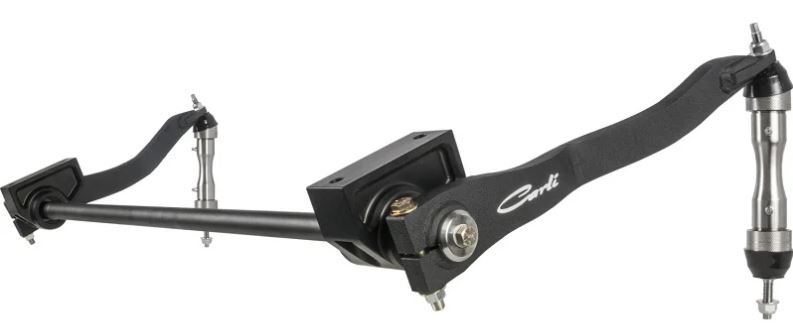
One of the last major options you’ll see while browsing suspension systems is an upgraded front sway bar. The factory sway bar is incredibly stiff, and while it does a great job at limiting body roll while cornering, it also contributes to a harsh ride quality since it effectively ties both front wheels together. If you use your truck for heavy hauling quite often, the stock front sway bar is best left in place, but if you only occasionally haul and spend more time driving empty and cursing the harsh ride quality it causes, you may decide to step up to a Carli Torsion Sway Bar, as its one of the single biggest improvements you can make to the ride quality of your solid front axle truck.
Which Suspension System is Best for You?
When it comes to lifting or leveling your diesel pickup, there are tons of options available which can change the parts cost greatly, but do you really need all the fancy bells and whistles? If all you want to accomplish is raising the truck to install larger wheels and tires, a basic leveling or lift kit will get the job done on a budget. However, if you want a smooth ride on the road, more wheel travel, and great handling off road, then stepping up to a premium offering will make you happier in the long run. However, you also need to be realistic about how you use your truck: unless your name is Robby Gordon, more than likely you don’t need a Carli Dominator system.
One last note worth mentioning is we did discuss most parts individually, but when you order your system, typically it comes as a kit with everything designed to work together. Carli for example, designs their springs to work optimally with their specific valving on their shocks, and while you can mix and match brands, its best to decide what your needs are, and buy the complete kit from one vendor. As always, if you have any questions don’t hesitate to pick up the phone and give us a call, and we can get you everything that will work for your specific needs and usage.

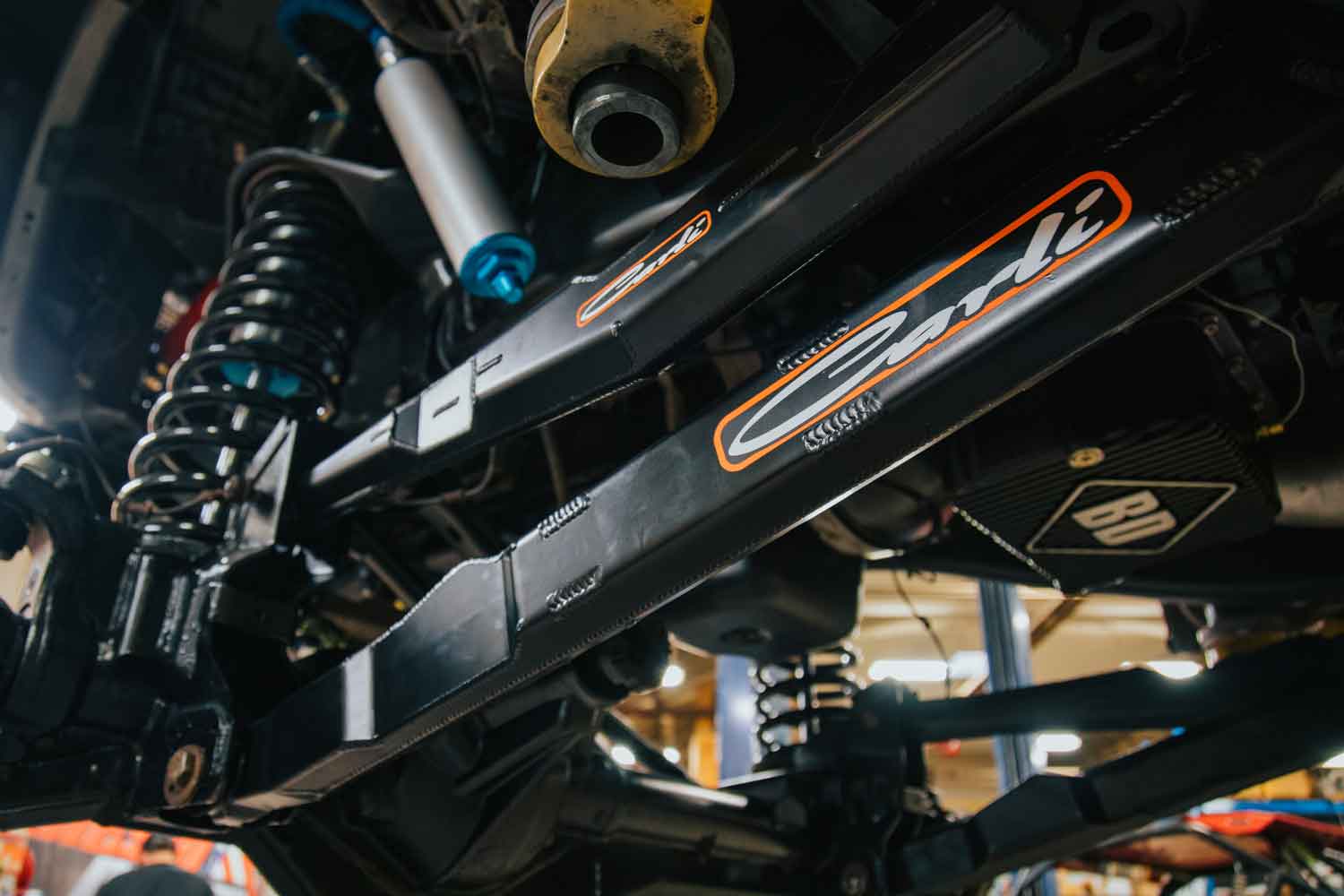
Suspension max kit for 2015 3509HD LTZ 4×4
CREW (srw) Duramax